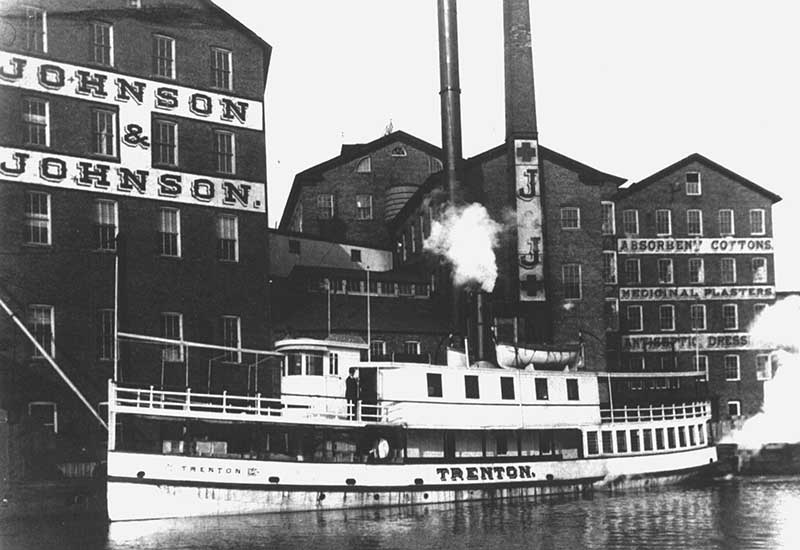Historic Background of the Delaware & Raritan Canal
By Gordon Perry
The importance of a transportation route through the central region of New Jersey to link Philadelphia and New York City was recognized by William Penn long before the American Revolution. The conclusion reached by a study commissioned during the presidency of Thomas Jefferson in 1807 indicated that a system of roads and canals would provide for the safe passage of goods and facilitate commerce. The study also indicated that the development of an inland navigation system extending from Massachusetts to Georgia would be an important asset for the developing country.
Although nothing was accomplished on the federal level, several attempts were made by a number of New Jersey canal supporters, but necessary funds were lacking. Finally, on February 4, 1830, the Delaware & Raritan Canal Company was incorporated by the state legislature with the provision that 5,000 shares of stock would be sold within one year and that the company charter would be withdrawn if the stock was not sold within that time period.
Since early stock sales were very disappointing, Robert Stockton of Princeton sought financial support for the canal building project from his father-in-law, John Porter, who was a wealthy Charleston plantation owner. Porter purchased the shares necessary for the company charter to remain in effect.
Canal construction began in 1830 under the direction of Chief Engineer Canvass White, who gained much experience in building the Erie, Union, Lehigh, and several other canals. The main canal was hand dug and lined with clay by immigrant and local laborers and extended a total of 44 miles from a southern terminus at Bordentown on the Delaware River to its high point of 58 feet at Trenton. The canal then travelled northeastward to tidewater at its northern terminus of New Brunswick on the Raritan River.
Since the elevation change on the main canal was only 115 feet, few locks were needed. Locks were numbered beginning at Bordentown with a total of 7 locks located between Bordentown and Trenton, and 7 additional locks between Trenton and New Brunswick. Since the canal became part of the Intracoastal Waterway, which provided passage between the Chesapeake Bay and New England, improvements were made to accommodate larger sailing vessels. The main canal was 75 feet wide and gradually deepened from 6 to 8 feet in 1851. Lock chambers were 24 feet in width and originally 110 feet long but increased to 220 feet after 1853. The canal also had several aqueducts, banks covered with stone (rip-rap), swing bridges to allow large vessels to pass, and an operating telegraph system over its entire length to communicate changes in water level, breaks in the canal, problems with the towpath, and to report any boat that violated the 4 mph speed limit. Mules were primarily employed to move boats through the canal, but steam-powered vessels were introduced in 1843.
Water for the main canal was supplied from the Delaware River by way of a 22-mile feeder constructed parallel to the river southward to Trenton and measuring 60 feet in width at the surface and 6 feet in depth. The feeder had only 3 locks over its entire length. A wing dam and guard lock, with no lift, was constructed about two miles north of Stockton at Bull’s Island to divert water from the river. A second guard lock, with no lift, was located at Prallsville to prevent flooding from the Wickecheoke Creek. In the summer of 1848, an outlet lock was opened at Lambertville to allow canal boats loaded with coal from the Delaware Division Canal in Pennsylvania to enter the D&R Canal and deliver coal to eastern markets. The feeder canal was completed under the direction of Ashbel Welch, who succeeded Canvass White as chief engineer. Vessels traveled northward on the feeder as far as Brookville, south of Stockton, and the last manufacturing center and former location of Deats Industries, a producer of stoves, farm plows, and other farm machinery from 1852 to 1881.
In 1831, The Delaware & Raritan Canal Company and the Camden & Amboy Railroad Company merged to eliminate competition between the canal and railroad. In 1871, the Pennsylvania Railroad Company leased the canal for 999 years and, after many years of financial losses, ceased operating the canal in 1933. The D&R charter specified that a state takeover would occur if the canal failed to operate for a period of three consecutive years. Accordingly, the Trenton portion of the canal was deeded to the city and filled in, while the canal south of Trenton was abandoned. The remainder of the canal was turned over to the state of New Jersey in 1937.
The main canal and feeder were converted to a water supply system, and rehabilitation began in 1944 with the replacement of locks with dams to control water flow. The New Jersey Water Supply Authority currently operates and maintains the canal as a water resource. In 1973, the D&R Canal was placed in the National Register of Historic Places and officially designated as the Delaware & Raritan State Park in 1974.

